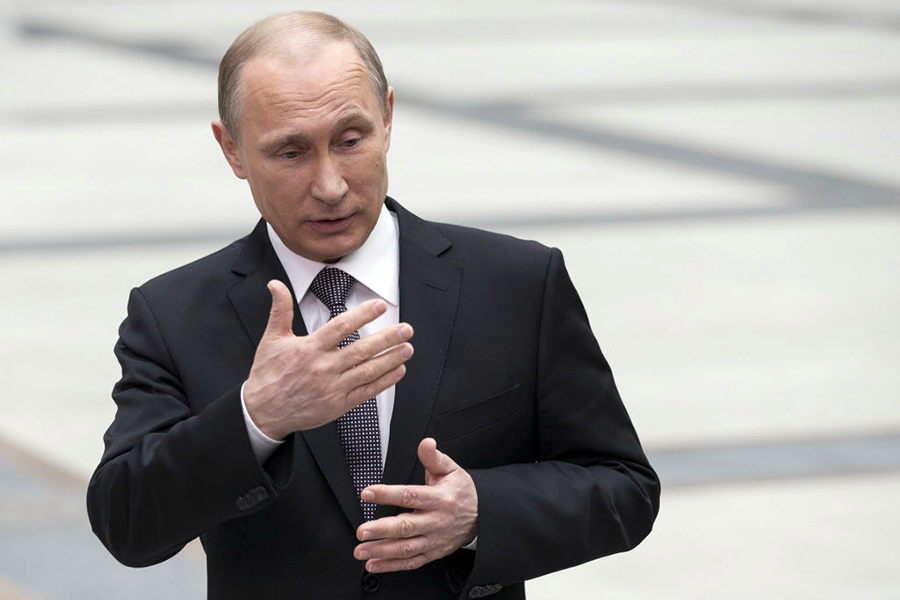Russia lifts ban on air defense sale to Iran. A game changer?
Loading...
| Istanbul
For nearly a decade, Iran’s elusive holy grail of military deals has been acquiring advanced S-300 anti-aircraft missiles from Russia.
So when Moscow this week reversed a 2010 ban on the $800 million sale, many Iran watchers rolled their eyes. Russia has a history of putting strategic politics before commercial transactions – including previous S-300 deals with Iran and Syria, and the fitful construction of Iran’s nuclear power plant at Bushehr.
But Russian President Vladimir Putin has made clear this is not a trivial move. Along with Iranian officials, he is portraying the S-300 deal as a “stabilizing” move in a volatile region, at a time when Russia is challenging the US and West over its annexation of Crimea, wars in Ukraine and Syria, among other issues.
Iran’s Friday prayer leaders hailed the resurrected deal, and congratulated the Defense Ministry.
Still, many questions remain about the timing of delivery, the significance of the upgrade to Iran’s defensive capabilities, and what it means for strategic calculations in Russia, Iran, the US, and Israel, less than three months before a deadline to reach a final accord that curbs Iran’s nuclear program.
“There are optimistic guys who insist that [S-300 delivery] will take a few months. And there are realistic ones who say it will take from 1-1/2 to 2-1/2 years,” says Alexander Golts, a military analyst in Moscow.
“We don’t know for sure [how well] Israeli or American jets can counter this system, but let us take into account that it is a modern, strategic air defense system, totally different from what the Iranians had before,” says Mr. Golts.
Under a framework deal between Iran and the P5+1 powers reached on April 2, Iran agreed to limit its nuclear program in exchange for lifting sanctions. The deal would also update UN Security Council resolutions that sanction Iran – and prohibit the purchase of offensive missiles or technology – though some provisions are likely to remain.
'Exclusively defensive weapon'
However, Russia maintains that those considerations do not apply to its delivery of anti-aircraft missiles to Iran.
The S-300 is “an exclusively defensive weapon and absolutely does not threaten Israel,” Mr. Putin said Thursday in a phone-in program with Russians. He noted that Moscow had in the past blocked delivery of S-300s to one Arab nation so it could not shoot down Israeli planes – he did not name Syria – and had to repay $400 million for reneging on the deal.
“With the progress of the Iranian nuclear track – and that is obviously positive – we do not see any reason to continue to keep the ban [on the S-300 deal] unilaterally,” Putin said during the call-in show. He specifically said such systems “are not included in the UN sanctions list.”
Russian Foreign Minister Sergei Lavrov also said the sale is not banned by UN resolutions, and “was done in the spirit of goodwill to stimulate progress at the talks.”
The White House said the US had “expressed our concerns directly to the Russians” about the sale. And Israeli Prime Minister Benjamin Netanyahu said he has “grave concerns” about the S-300 deal. However, the US State Department noted the deal did not violate UN sanctions.
Timing of delivery unclear
For the Iranians, Putin’s decision was welcomed as a sign of warming bilateral relations after years of turbulence. When it froze the S-300 deal in 2010 under US and Israeli pressure, Russia returned a $167 million cash advance. Ahmad Vahidi, Iran’s defense minister at the time, said Russians had “dishonored themselves globally” and “proved they are not trustworthy.” Iran filed a $4 billion lawsuit in the International Court of Arbitration in Geneva that is still pending.
Iranian Defense Minister Hossein Dehghan said this week the S-300 system could be delivered this year. Russian officials and analysts suggest a six-month to two-year timeline is more likely, depending on the version of missiles and whether they would come from Russian military stocks or manufactured from scratch.
The missiles fly at supersonic speeds with a strike range of 120 kilometers (75 miles) against aircraft, cruise missiles, and – for later versions – ballistic missiles. They carry a 145-kilogram (320-pound) warhead, and are difficult to intercept.
An analysis by IHS Jane’s Intelligence Weekly notes that Iranian operators already trained on the system before 2010, and the S-300 deployment would make a US or Israeli strike on Iranian nuclear sites “much higher risk and of problematic effectiveness, as non-stealth jets would be easily targeted.”
“Delivery of the S-300 is [a symbol of] the West’s defeat by Iran’s resistance,” said Iranian lawmaker Avaz Heidarpour, a member of the Parliament’s National Security and Foreign Policy Commission.
“After recent events and regional crises, Russians understood that in order to make a united front against external forces and those who endanger the region’s stability in favor of the West, they must deliver the [S-300] system to Iran,” said Mr. Heidarpour, according to the Tasnim news agency.
Russia's relations with West have changed
In 2013, Mr. Dehghan said Russia was using UN resolutions “as an excuse” and that the “wisest thing is for them is to believe in themselves and not follow Americans’ policies.”
Russia’s testy relations with the West could not be more different now, as it lifts the ban on sale of the S-300.
“Part of the argument is sanctions are going anyway, so Russia should rush in before the Americans befriend Iran and we lose that market,” says Pavel Felgenhauer, a military analyst in Moscow.






